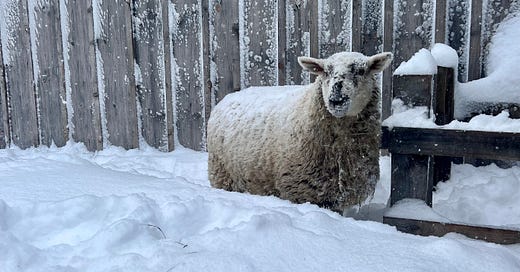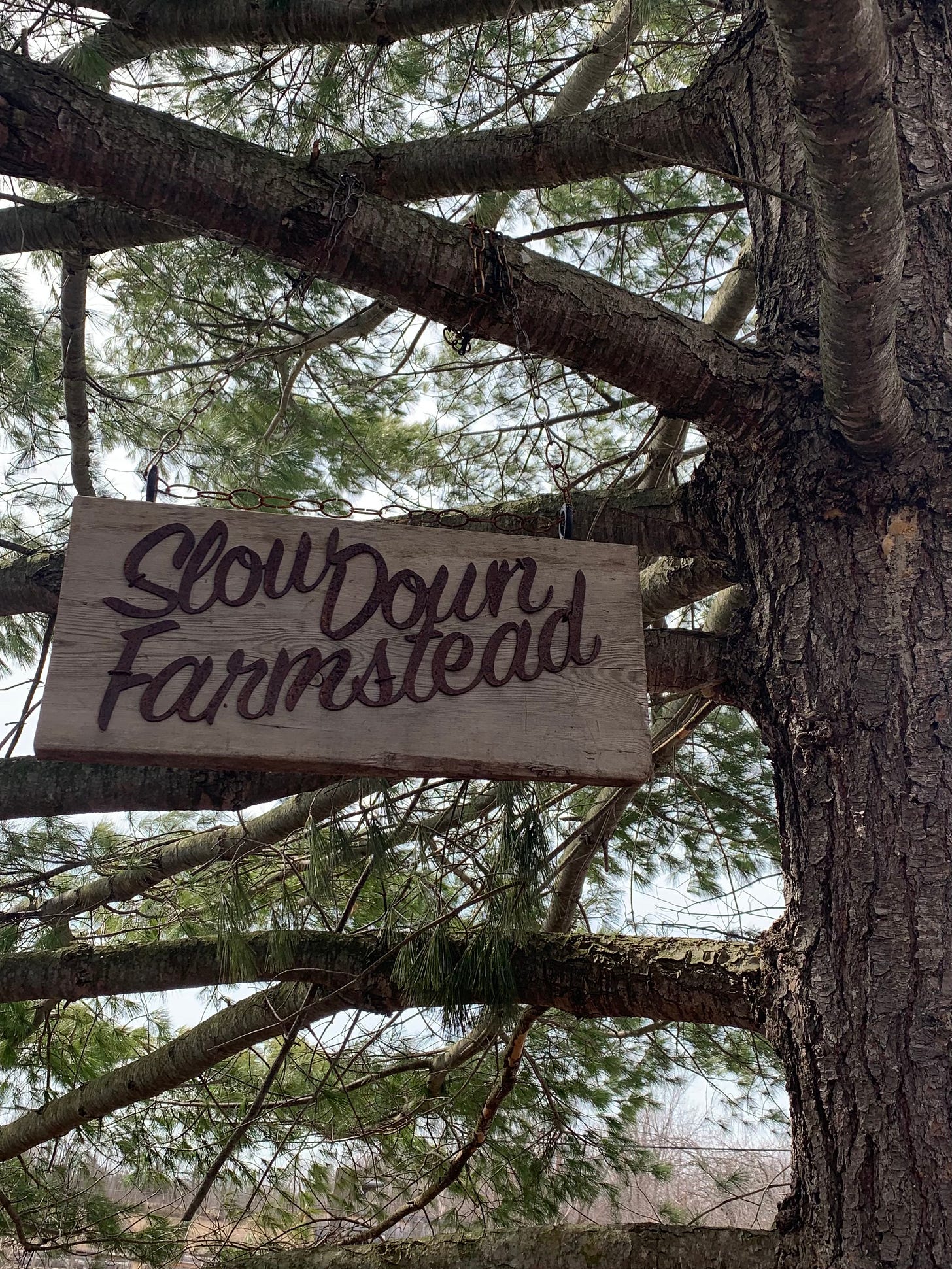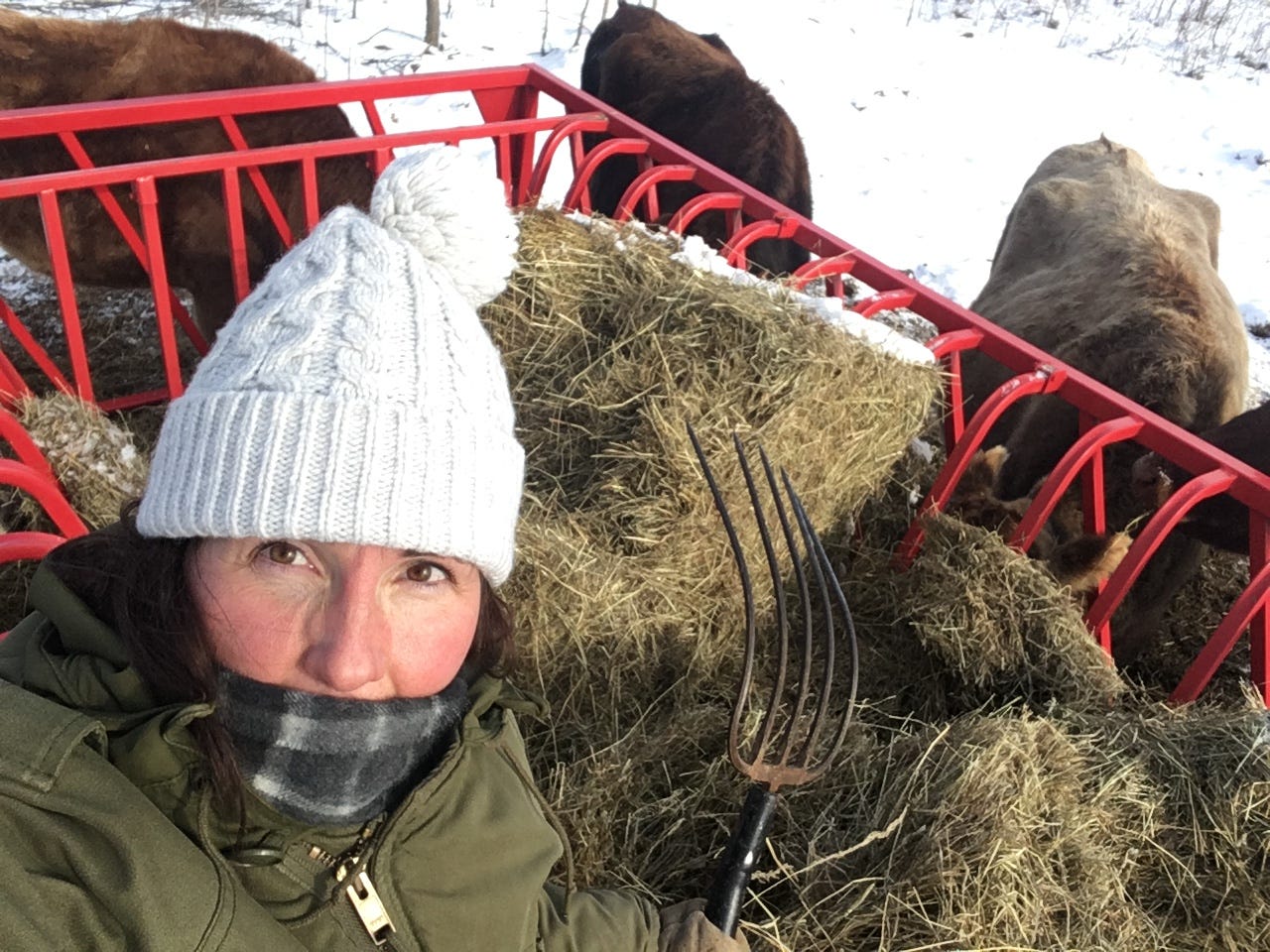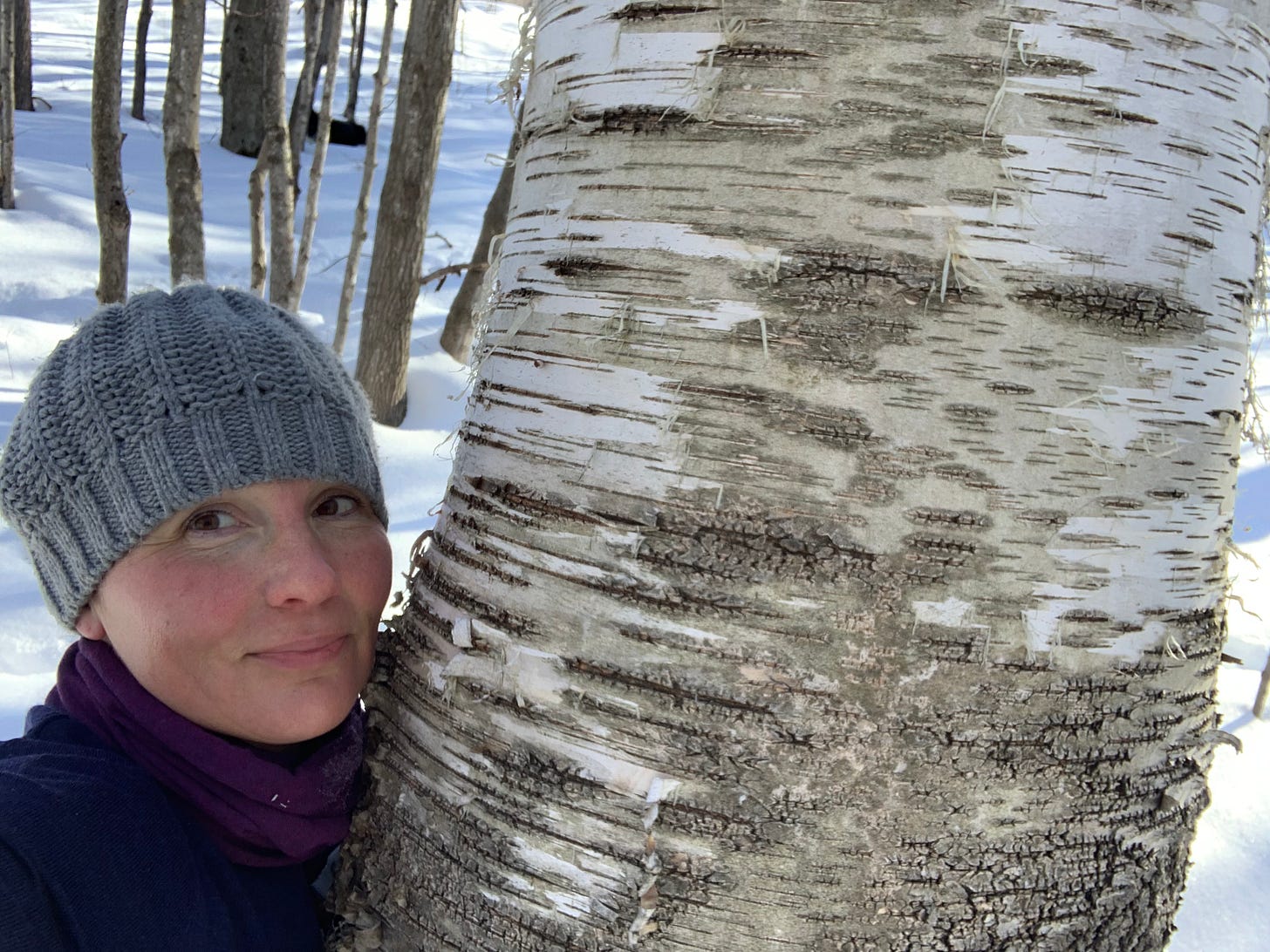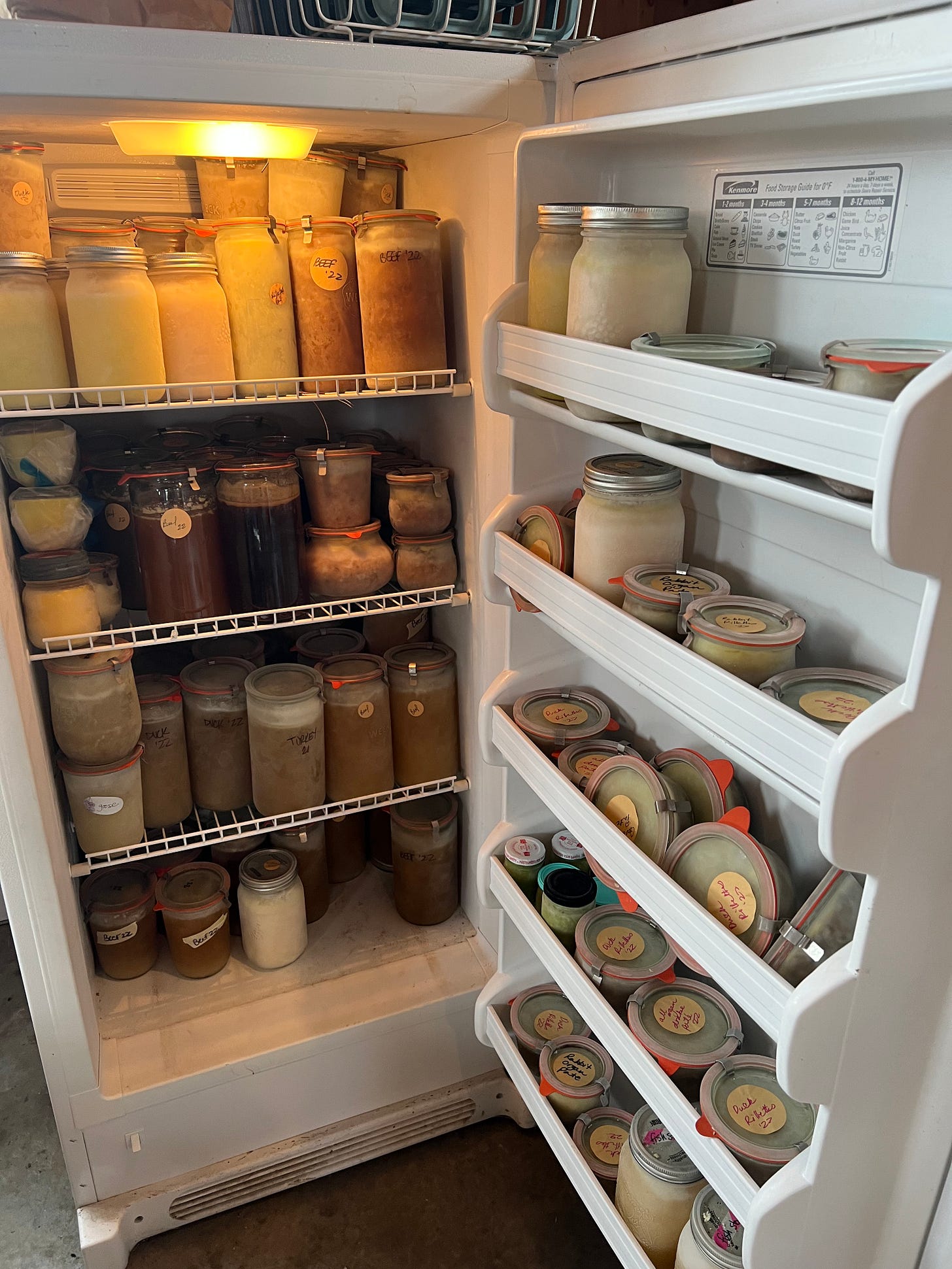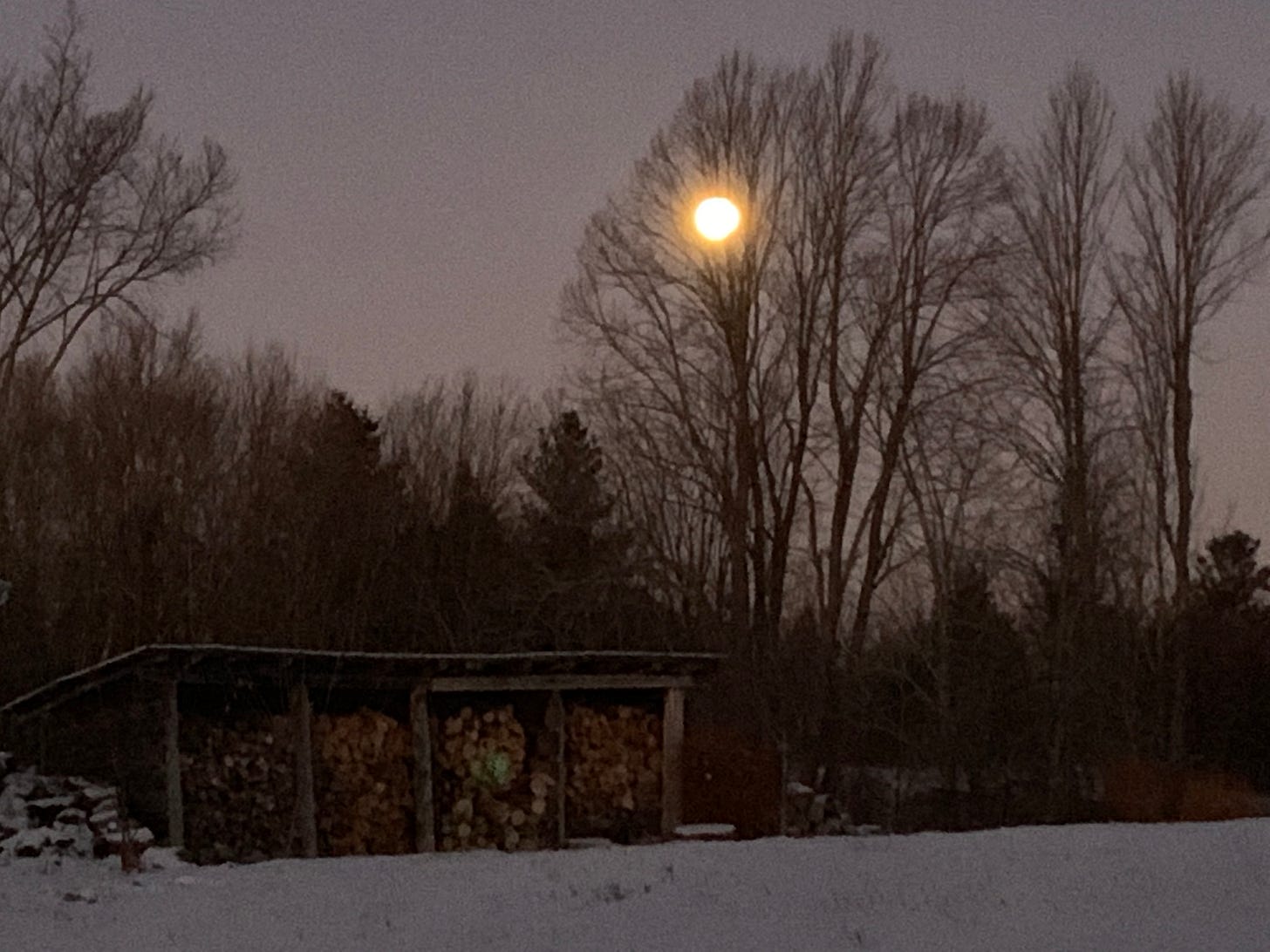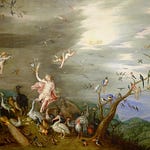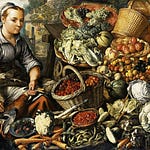I had it suggested to me that a day-in-the-life type essay is about due. I must admit, I do like a good day-in-the-life. It’s fun to see how other people cobble their lives together to excavate the meaning and pleasures in a day. So, I’ve agreed to the challenge. I thought this might best be done with pictures and commentary.
My intention here is to be as real as possible. I wasn’t going to save up some unusual outings or events to make things more exciting or dramatic. Those are things I’m happy to avoid for the most part anyway. What I share here is a typical day in the life of me, a homesteader and writer living on a farm plunked firmly on the Canadian Shield. A rock. I live on a big, frozen rock. And hallelujah for that! I’m going to include in this day the things we do for our health and wellbeing because they are a part of our lives, as integral and routine as eating and sleeping.
I’m going to try to do these types of essays seasonally so I can show how much our lives change throughout the year. Over the course of the next year, maybe two, I will put these together so they can be read in succession to illustrate how woven our lives are into the seasons. This is the connecting thread throughout the book I’m currently writing.
I’ve been asked to show how I combine my “bullet journal” with my “deep work” schedule by a few of you here. Nothing happens in my life without the structure of my schedule. I’ve included this peek as a little thank you perk to my paid subscribers. You can access those pictures and explanations here.
So without further ado, a day in the life of Slowdown Farmstead:
Winter on our little farm is about rest. It doesn’t mean we don’t work or move or have tasks to do, but everything is decidedly slower. Chores are quicker because we don’t have to move cattle every day. They live in their winter area complete with their winter barn to keep them sheltered from fierce wind, wetness, and the cold of our winter seasons. Chores are also done later than they are in summer. Everything of summer rustles and bustles us to get moving, from the sun that rises earlier and earlier, the days that stay longer and longer, the frogs that peep and the whippoorwills that sing from dusk to dawn, and the chorus of songbirds that usher in every day, singing to raise the sun.
In spring and summer we raise, grow, forage, and plant all of the food we eat. That means we must milk, dry, can, store, butcher, culture, ferment, smoke, cure, freeze, and freeze-dry all of the food by autumn. The pace is demanding but we always build pleasure and calm into every day. Life is perspective, after all. Still the reality of the demands on one’s body remain. We are always, always so grateful for the arrival of the slowness of winter. Winter is a good friend, one that comes up quietly alongside you, slips an arm around your shoulders, offers a steaming mug of something lovely and says, “Enough now, come with me.”
So here we are, with winter on our little farm in the woods.
0600: Wake up. Start fire(s). Troy starts a fire in one room and I get the kitchen wood cookstove going. Drink solé. Meditation and prayers in front of the fire with a sleepy Great Dane.
Because this is winter and the land is dark, and the days very short, we need to do a little more work to protect our circadian rhythm in the mornings and evenings. That means a few things for us. First, we wake up later and go to sleep earlier. It’s interesting how this is what our bodies ask for after the mammoth push of spring, summer, and fall. Longer nights must mean we need that sleep, right?
We wear blue light blocking glasses when we wake up in the morning and once the sun sets in the early evening. We use candle and lantern light throughout our house at these times for the most part. We stay off screens, but if we have to go on something, our glasses are on. Firelight is what we try to rely on the most. We also use red incandescent lighting.

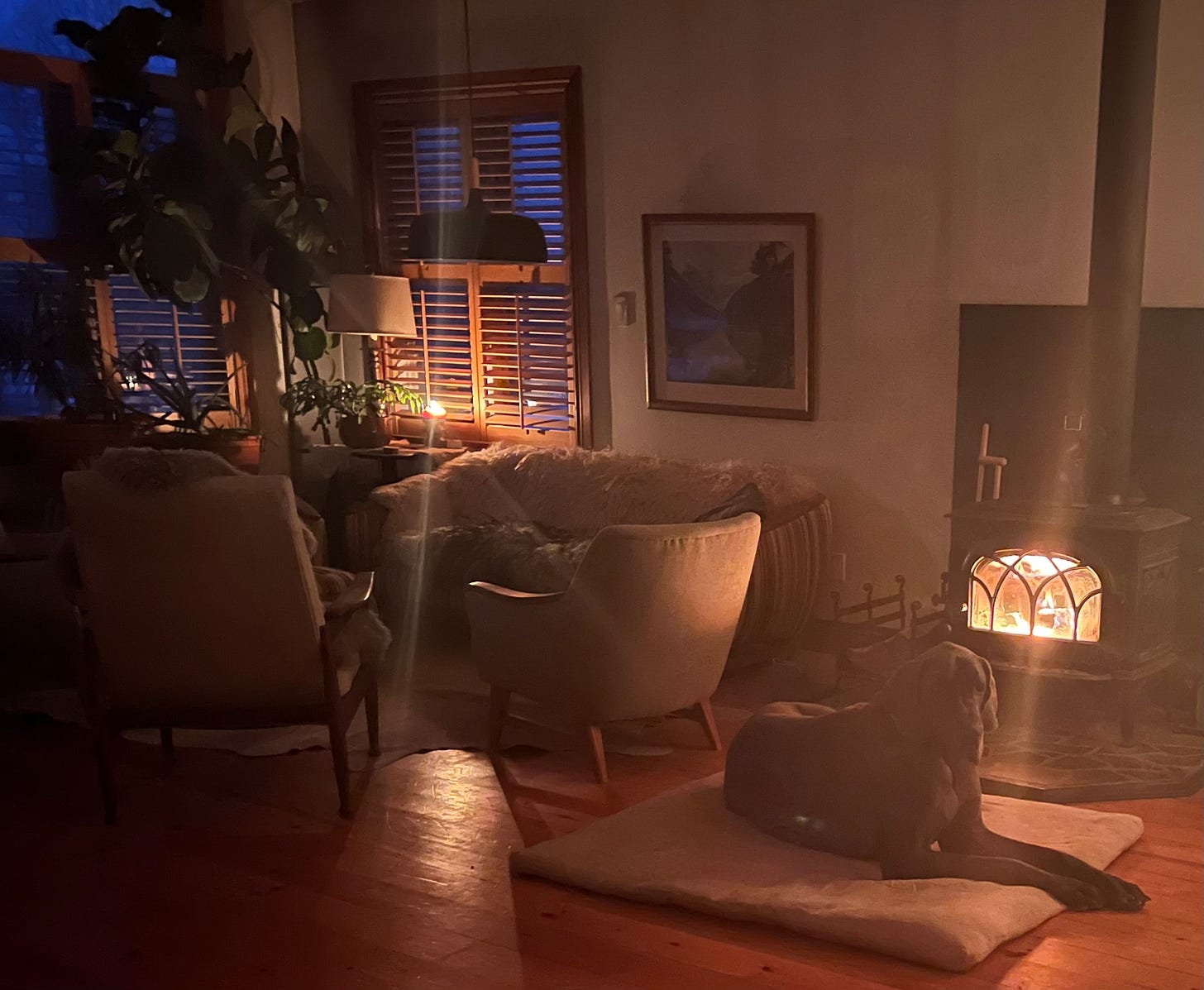
0700: Work out (weight lifting with 1-2 times interval training/week). We cobbled together a home gym over the years. It took a good long while, but now we’re pretty happy with our set up. Before we had a home gym we worked out in military gyms or, if we were somewhere without one, we used commercial or university gyms. I remember one year finding out that a hospital, which had a free-weight gym in it for the use of their staff, was going to be closing the gym due to insurance reasons. Troy asked if we could buy the equipment, which consisted of dumbbells, a squat rack, and an olympic bar/plates. They sold it to us for a few hundred dollars. What a score! The problem was getting all of that heavy equipment down from the sixth story, to a loading bay, and then into our little Toyota. Happily, a friend loaned us their truck and we employed our daughters as pack-mules for the endeavour. A royal pain to be sure but long forgotten when we get to work out in our own private gym.
Our gym is in an outbuilding that also houses our freezers, meat cooler, and butcher shop. We finally insulated it this year so I don’t have to work out in an oversized parka anymore. Luxury!
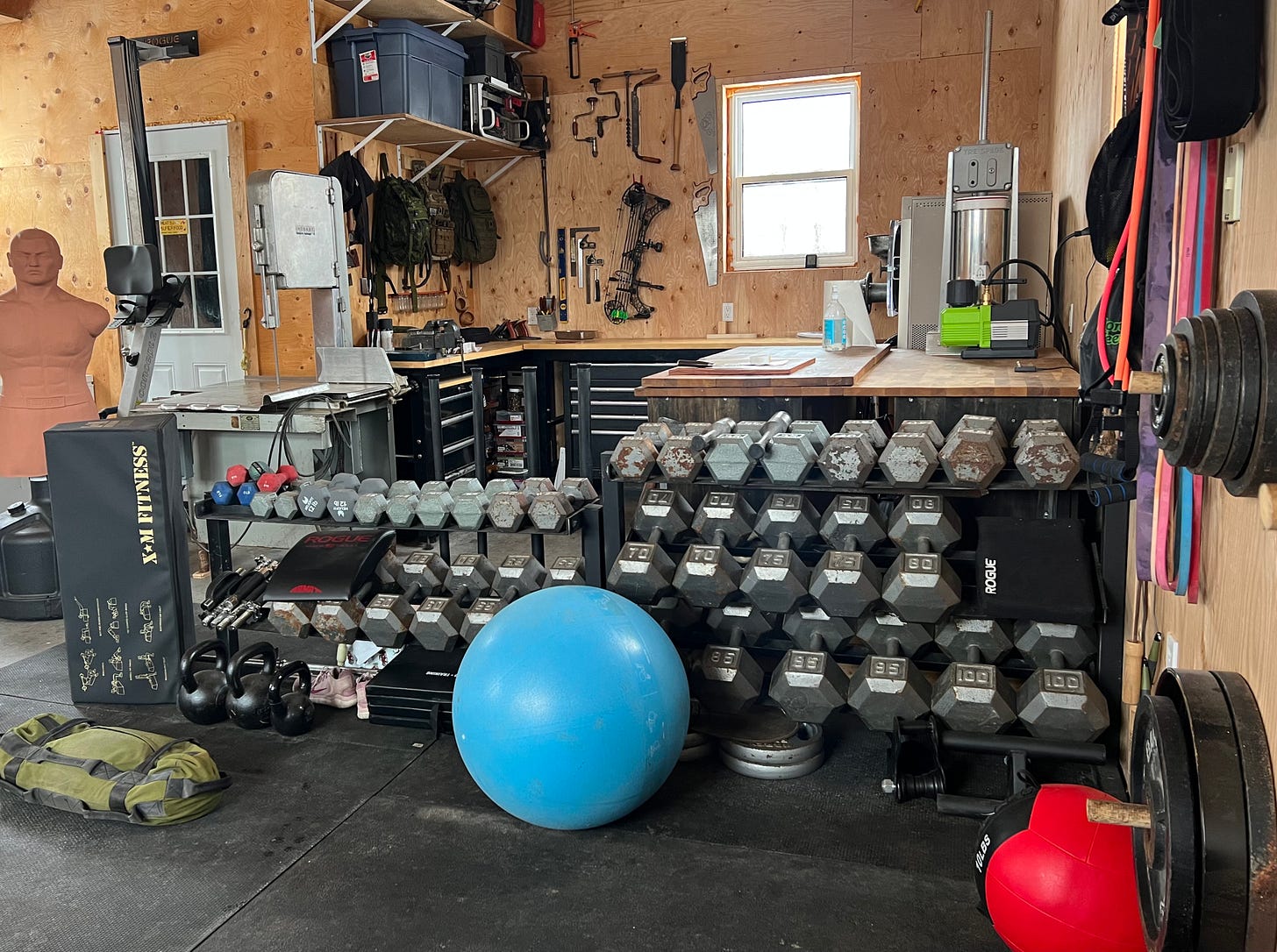
0745 (or whatever time is sunrise): Step outside and watch the sunrise for five minutes. This ensures my circadian clock is in rhythm with where I am. This affects every facet of my health. If any of this is new to you, you’ll find the couple of references at the bottom of this post a good jumping off point to understanding how essential light is to our health.
0800: Change into warm farm clothes and start chores. In winter, chores consist of the normal feeding and watering of animals, but all tasks are condensed in and around the barn instead of in pastures all over the place. The geese and ducks aren’t out in their pond in the field. The chickens and turkeys live together in their winter house. They share a fenced in area with the sheep who get locked up in the barn at night and live around the barn during the day, most certainly dreaming of green grass and wool shearing day. The cattle live a bit further up from the barn. Their lives surround their hay feeders and a lovely, three sided structure Troy built for them to keep them out of the wind and freezing ice.
Where we live, we go through multiple freeze-thaw cycles every winter. It makes keeping animals dry and sheltered a challenge. Last week we saw some -28c days and then, overnight, we’re just below zero degrees celsius. Then it will start raining which turns to ice, which turns to snow, and the temperature plummets. The cows will be wet, coated in ice and frost. I know in the dry cold of the prairie, cattle get a vertical wind shelter and that’s it. But getting cold and staying cold is, in many ways, easier on these lovely beasts than what they endure in our winters.
Along with watering, and there is always a sigh of relief when the frost free water hydrants haven’t frozen overnight (because that involves an incredible amount of extra time and energy to sort out), I top up the various animal’s minerals and supplements. The cattle get Redmond salt, humates (fulvic acid), bentonite clay (not every time), chelated minerals, and kelp from the east coast. The sheep get something similar but with their own mineral mix specific to sheep, higher in copper.
The cow’s have three feeders, two for round bales, one for the enormous large squares which weigh close to a ton each. I check those and feed them a new bale if necessary. If the hay has frozen or there’s been a big dump of snow, I will crawl up into the large square feeder and spread out their hay. I love this job. It’s an incredible workout and the cows all swarm the feeder and jostle for position around the weird two legged creature doling out the goods. Sometimes I just sit down in there and listen to the sound of them eating for a spell. One of my favourite farmer perks.
The sheep are then let out of their nighttime confinement and fed their hay and a treat of alfalfa pellets. The turkeys and chickens get their pre-soaked ration from the night before. Their shared waterer is checked and the ice on top broken and removed. The ducks and geese are let out of their area, fed their grain and hay, and watered. Ducks and geese eat a good amount of hay in the winter. They’re more interested in hay than their grain. Chickens and turkeys, on the other hand, will only nibble on hay and far prefer their guts (saved from ruminants butchered earlier in the fall), trim, and clabbered milk soaked grain concoction.
Feed, water, love-up barn cats. Put feed in a back corner for the old barn cat the others are mean to so she can eat in peace. She’s earned it.
Collect branches and twigs with buds on them for our meat rabbits. Feed and water rabbits, add extra bedding because they have, as sure as day, started to dig another tunnel in their never-satiated need to dig. I foil their plans again by evening out the ground in their house and quietly whisper a prayer of thanks to my man who had the forethought to cover the entire ground and up the walls with welded wire hardware cloth. “Nice try, wascally wabbits, you ain’t going anywhere!” Give them each a little mountain of hay to carve out into a bed, or to eat, or a little of both.



0830: Make breakfast. Breakfast is usually leftovers or a steak. Whatever it is, it’s high fat and protein. Feed dogs before I eat lest they create a pool of slobber at my feet. Eat a relaxed breakfast with my dreamboat. Talk about our day to come. Clean up after breakfast.

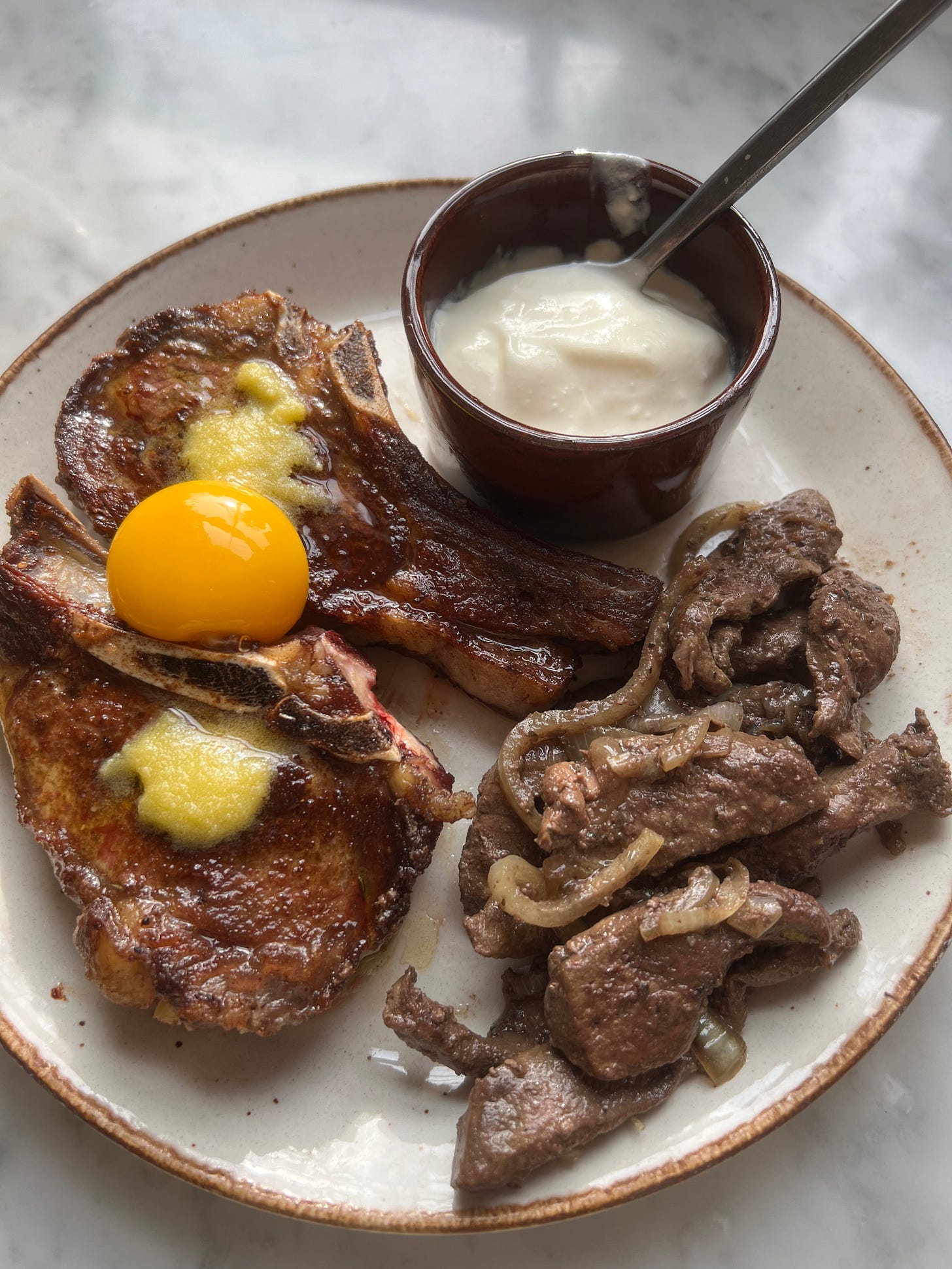
0930: Walk dogs in forest. If I do this right, it will take me an hour. If I do it wrong, I will be done in thirty minutes. This is a time where I do some grounding as well. In winter, that looks like hugging a tree for ten minutes or so, however long it takes for my heartbeat to align with the pulsing flow of sap in the tree. Sometimes I lay on the frozen ice of the lake or beaver pond and watch the ravens put on a show. Slow and methodical, that’s what I’m after in the wilds. Too fast, too distracted, and I miss all the things I’m being told.
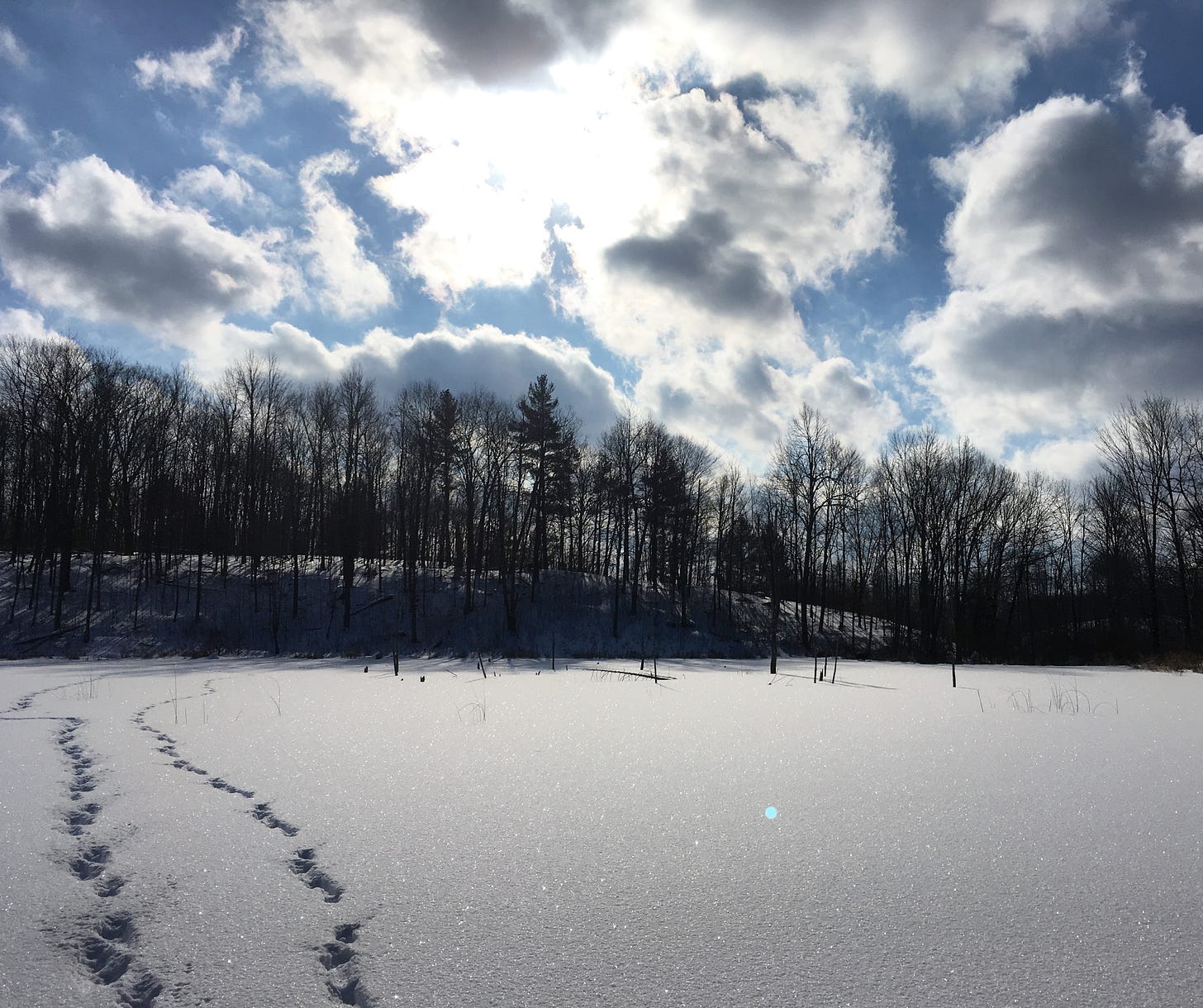
1030: Feed dogs their after-walk bones. Have a shower. Make a pot of tea.
1100: Sit down to write. This is book writing time.
1300: Get outside and move for a bit after sitting. Today I restocked our tinder supply.
1330: Sit down for an afternoon meeting with hubs. If it’s warm enough we do this outside. We just sit and talk. I will often read out of a book that we’re reading together. In the summer, these meetings are usually an hour long because they need to be with the volume of work and length of days at that time. Pleasure must be built into every day. No exceptions.
1400: On this day, I reviewed my saved seeds and reorganized it into this time block of my schedule. My seed ordering has been dramatically streamlined over the years. We don’t eat nightshades so no seeds needed for them other than the potatoes, but we keep our own seed potatoes. I don’t grow high oxalate vegetables so no spinach, swiss chard, or sweet potatoes necessary. Mostly, my vegetables are now things that I like to ferment, can, or store over winter or things to delight in, fresh, during the growing season. Things like five or six varieties of radishes, heavy-leafed, substantial lettuces, herbs of all sorts, a multitude of summer squash varieties (which I love fermented for winter eating), winter squashes (which are the bulk of any carbohydrate we eat in winter), sweet shelling peas, etc..
Note: this time block is usually reserved for working on my “year of the house” projects, but I had to get my seeds squared away. “Year of the House”, as I wrote about before, includes both the house that is my body and the brick and mortar one that we live in. Normally, at this time of day, I am painting, sanding, tearing apart or building up something in the house or I am in the sauna or doing light therapy. Yesterday, I finished painting the walls in the summer kitchen.
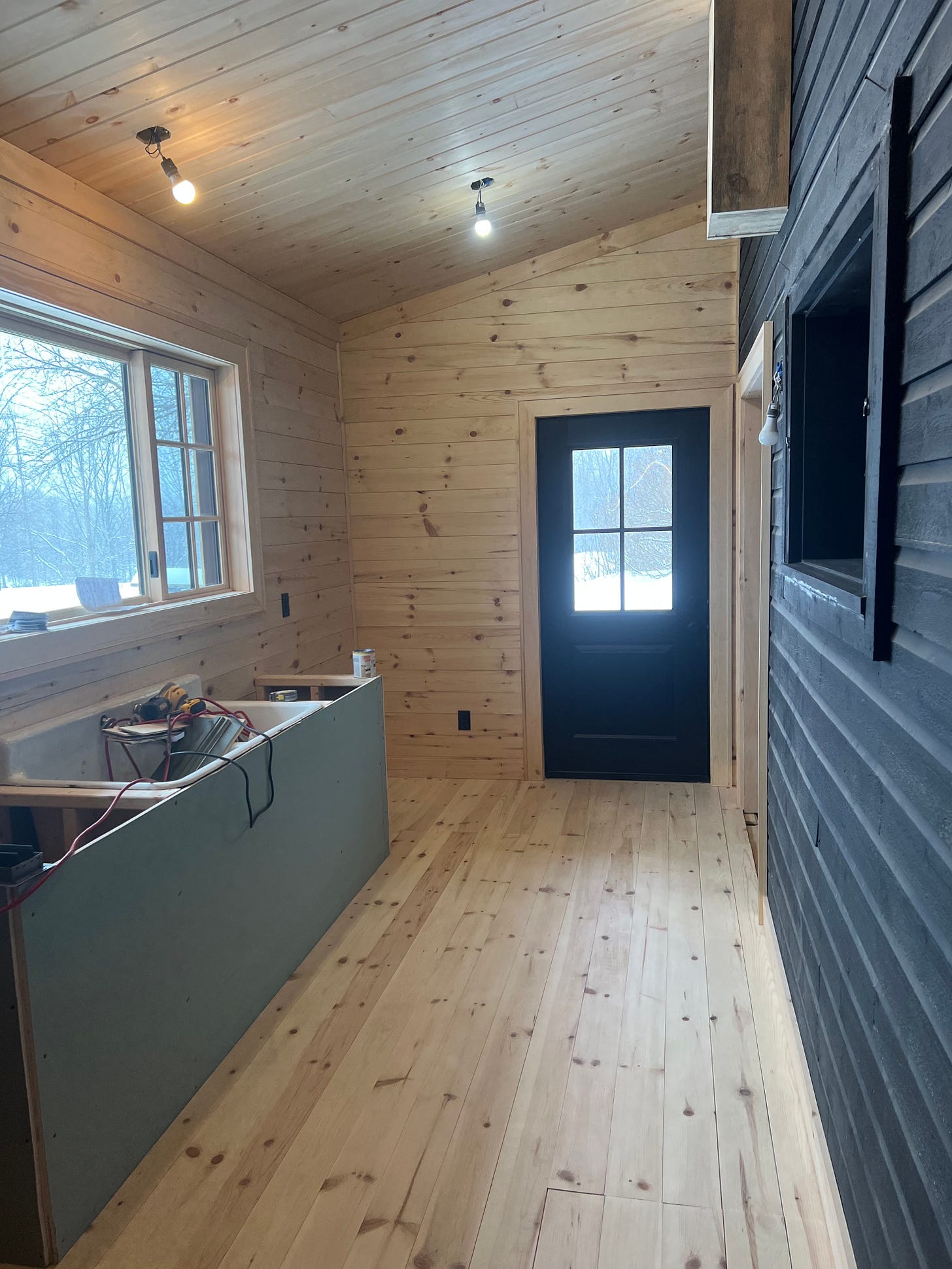
1500: Make supper. Depending on what I’m doing this is an hour or fifteen minute process. Today I’m cooking up some lamb chops with potatoes roasted in duck fat for the other two eating with me. I skip them potatoes. While the chops are cooking, I do my second, twenty minute meditation of the day. We use the Ziva meditation methodology and love it. It’s the only meditation we’ve been able to consistently stick with for years.
1600: Eat supper. We eat twice a day and try to always eat while the sun is still up. We also avoid eating three hours before sleep. That’s been a practice of ours from the very beginning. Now, we’re scooching that up, trying to get closer to four or five hours before bed. Supper is leisurely. We light candles. We talk. We dawdle. We enjoy. We slurp. We use our fingers.
1700: Evening chores done at sunset year round (timings shift as the sun goes down later). This way we get those signals to our brains (nighttime is here) and it’s easy to lock everyone up. The animals who don’t have the bad fortune of being controlled by clocks and electric lights, know when it’s bedtime better than we do.
Evening winter chores are the easiest of any chores in the whole year. We’ve already addressed anything frozen or needing of more bedding in the morning. Everyone is fed. This is just tucking everyone in, but they really do that on their own. When we go outside, the ducks and geese have left the yard and are all hunkering down in their house. We just shut and secure the door. The barn cats get a second meal because it’s cold and they need it. The chickens and turkeys are all roosted, again we just shut the door to their home. We feed the sheep some alfalfa to get them into the barn where they sleep, safe from coyotes. The cattle get blown a kiss. They don’t get anything else. No milking for us in the winter. Thank goodness. The rabbits get their frozen water switched out for something fresh.
On the way back into the house, we grab the food we will need for tomorrow’s meals from the root cellar and freezers. This is where I decide what we’ll eat the next day. Some people ask me to show them my meal plans. I have never had a meal plan in my life. Here’s my meal planning: look in freezers the night before, “hmmm…. what looks good? Lamb, yes, I could go for lamb. What should we eat with the lamb? In my case nothing, but I’ll get some of that minty herb sauce I made in summer and grab a couple potatoes for Troy that I’ll roast in duck fat. There’s duck fat in the house. I’ll grab some potatoes from the root cellar.” I almost always grab a jar or two of bone broth from the bone broth freezer.

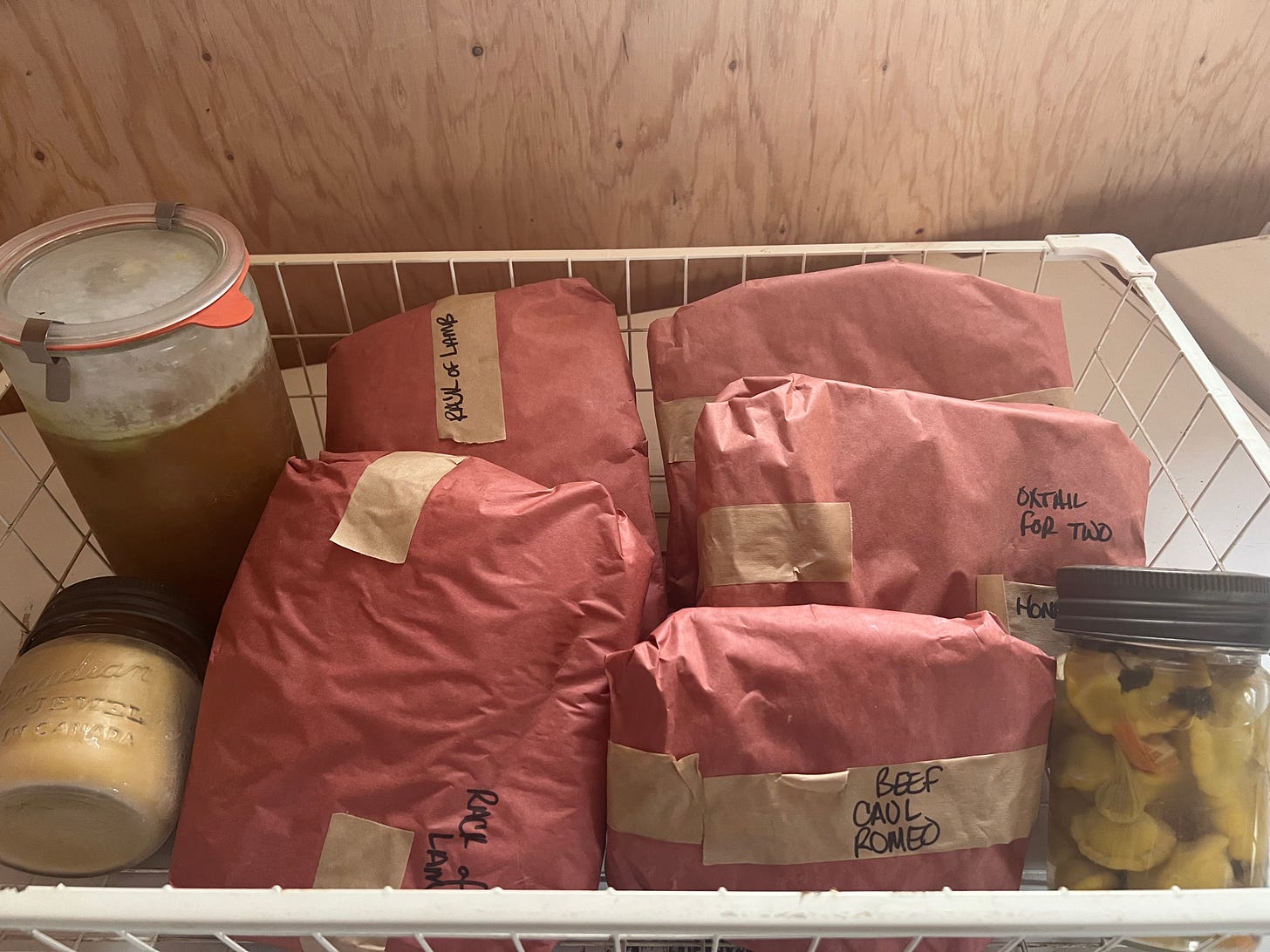
1730: While one of us was doing chores, the other was cleaning the kitchen after supper. After jointly finishing that, this is the time when I return to writing, answering comments, and researching things. This is also the time when I write my schedule for the next day. Troy will work on various projects he has going on or answer some emails. Blue blocking glasses on and screens void of blue light with f.lux.
1800-2000: Play a board game, read, work on a rug I’m making. Troy carves wood and is working on a wonderful super secret project I cannot divulge less the recipient’s eyes fall on these words. It’s good, that’s all I can say. Sometimes we hang out in the wood fired hot tub. Tonight we did just that. Nothing quite like being in hot water when the air all around you is freezing and the stars are clear and brilliant. It’s magical, that’s the truth of it.

2000: Night time ablutions. Read or mess around for awhile. Bedtime.
I’m hoping I can put these together as a series so the cycles and shifting demands of a year can be better understood. I’m starting with winter, a time of rest and slowness. Recovery. So this is only part of a story and tells little of the whole. This is the time we think about when we are being run off our feet in spring and summer. These early bedtimes and warm winter fires are the things our dreams are made of when we’re butchering our third steer, preserving everything we can in some form or another, setting up electric fencing every day when we move the cattle and sheep, and milking cows and then making sure we honour the gifts of our benevolent bovines by making butter and cheese.
All of that will come again soon enough, the blooming of life. Some of us will be here to witness the blooming of those spring flowers, some of us won’t. Songbirds will return, bringing that bright, verdant green on their wingtips. Spring Peepers will sing their relentless chorus. The endless dandelions, each crowned with a fat bumble bee crashing about. And of course, my favourite, the return of cows onto the sweet grasses. Oh, to witness the joy! Even my old gal, Bea, running and doing her best bucking bronco routine, kicking up her heels in sheer bliss at the return of the sweet and juicy. What can a farmer girl do but plunk herself down amongst those beautiful beasts and listen to the sound of them eating. Nothing like it in the whole wide world. All of life conspiring to usher in spring.
Whoever makes those white sound machines has really missed the boat by not including the sound of cow’s eating grass in their repertoire.
But that is not now. And in every season, joys of its own. The being here means we are here, now. When we were not tied to what the seasons brought, we spent great chunks of our lives looking forward, planning, strategizing. That’s important too, but not as a way of being. As a way of being, that trait can be torturous. We are here, in these moments living with an eye to the future and an appreciation of what’s past, but immersed in the present. In everything hardship and beauty. That’s a certainty. They are inextricably woven together. You can see it in everything if you’re here for it, too. Those are the gifts that the seasons bring to our lives.
There are thousands of books on the topic of circadian rhythm, the effects of certain types of light on our bodies throughout the day, sun gazing, and aligning ourselves with the rhythms of our days and the seasons. Start researching with those key words. Podcasts are a great place to get started. Here’s one to start the fun.


